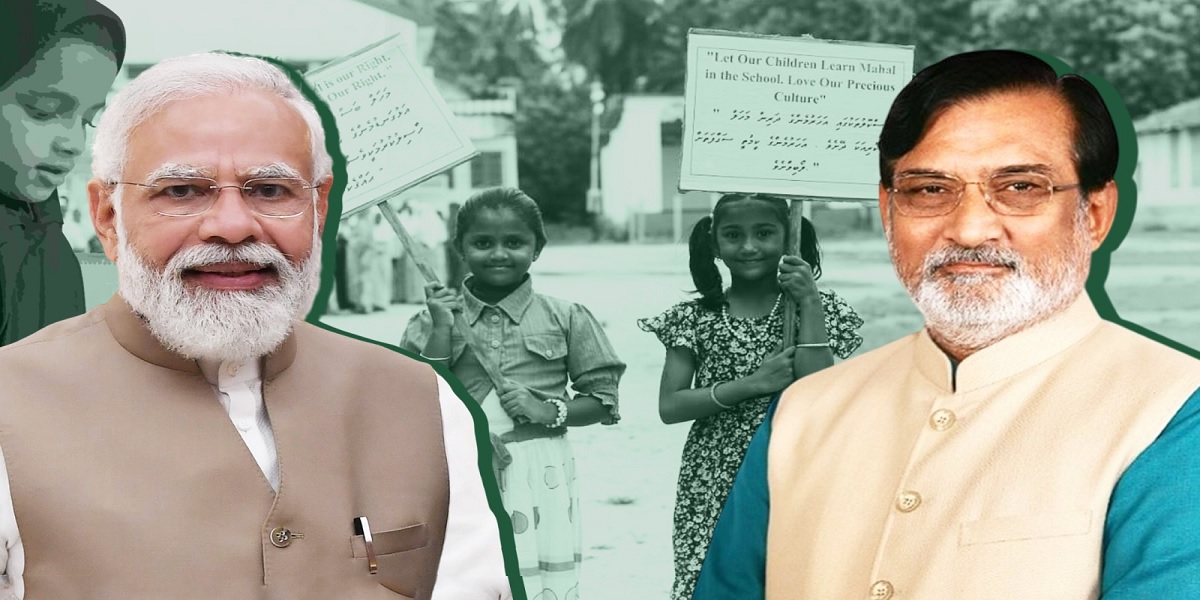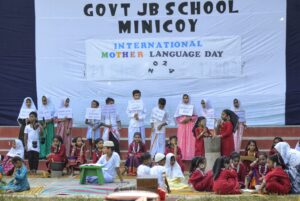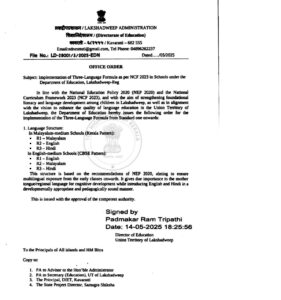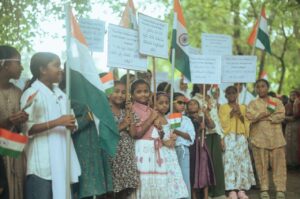The entire Lakshadweep is protesting, as the Mahal and Arabic languages that are deeply rooted in the island's culture are being pushed out of schools and replaced with Hindi.
Published Jun 04, 2025 | 1:00 PM ⚊ Updated Jun 04, 2025 | 6:00 PM

Is PM Modi's Policies accelerating the death of regional languages?
Synopsis: The implementation of the three-language policy in Lakshadweep has sparked protests and condemnation, as the languages native to the islands or widely spoken by the islanders are being ignored. Many believe that the imposition of Hindi over Mahal or Arabic is part of an attempt to erase the cultural identity of the islands.
“On 21 February every year, we celebrate International Mother Language Day, as a day for our Mahal language. But I don’t know if we’ll be able to celebrate it in the coming years. Our children are being denied the right to learn their mother tongue, Mahal — the language of Minicoy Island,” a Mahal language teacher from Lakshadweep told South First.
This isn’t just a teacher’s worry. The entire Lakshadweep is protesting, as the Mahal and Arabic languages that are deeply rooted in the island’s culture are being pushed out of schools and replaced with Hindi.

On last year’s Mother language day, students of JB School celebrated Mahal Day, highlighting its deep-rooted cultural significance in Minicoy.
The move has raised serious concerns over constitutional rights. Article 29 of the Constitution guarantees the right of any section of citizens, including linguistic minorities, to conserve their language, script, and culture. Article 350 A mandates that states provide primary education in children’s mother tongues.
The three-language policy in the National Education Policy (NEP) 2020 emphasises the importance of learning in one’s mother tongue. It recommends that the medium of instruction should be the mother tongue at least until Grade 5, and preferably till Grade 8 and beyond. What is happening in Lakshadweep under Administrator Praful Khoda Patel is just the opposite.
DMK MP Kanimozhi’s viral response to a foreign journalist’s question, What is India’s national language?, was “It is unity in diversity.” However, what about the people of Lakshadweep? Why is their protest falling on deaf ears?
Are Prime Minister Narendra Modi’s policies accelerating the death of regional languages? And more importantly, are we silently witnessing the slow death of India’s diversity?

Circular regarding the implementation of the Three-Language policy by the Lakshadweep Administration.
Congress MP Muhammed Hamdullah Sayeed told South First that Mahal is central to the islander’s cultural identity, as it reflects the language of their ancestors, while Arabic remains vital to their religious life. Now, the NSUI has taken up the issue.
”The order, signed by Director of Education Padmakar Ram Tripathi, completely sidelines Arabic and Mahal, two languages that are not just academic subjects but hold deep cultural and religious relevance in Lakshadweep,” NSUI Lakshadweep President Ajas Akber PI told South First.
The policy, according to the official directive, introduces Malayalam, English, and Hindi as the compulsory language sequence in all schools. In Malayalam-medium schools (Kerala pattern), R1 – Malayalam, R2 – English, R3 – Hindi and In English-medium schools (CBSE pattern), R1 – English, R2 – Malayalam, R3 – Hindi.
As a solution, Lakshadweep people proposed adopting a flexible model for Kerala-pattern schools, R1 – Malayalam/Mahal, R2 – English, and R3 – Hindi/Arabic and for CBSE schools, R1 – English, R2 – Malayalam/Mahal, and R3 – Hindi/Arabic.
”The NEP 2020 and National Curriculum Framework (NCF) 2023 recommend multilingualism, but the Lakshadweep administration’s version imposes a one-size-fits-all model that erases our linguistic identity. Arabic is critical to Islamic education, and Mahal is the Minicoy people’s mother tongue. The exclusion feels like cultural erasure. It is “unilateral and insensitive.” Ajas told South First.

Primary school students in Minicoy took to the streets with placards in the Mahl language, demanding its inclusion in the school curriculum. (1)
Due to its deep-rooted cultural ties with the Maldives, Minicoy stands apart from the other islands in Lakshadweep, sharing many similarities with the Maldives in language, cuisine and traditions.
The local language, Mahal, also known as the Maliku dialect, is a variant of Dhivehi, the official language of the Maldives.
Although Mahal and Dhivehi share the same script, they differ significantly in pronunciation and usage — much like how Malayalam varies from Manjeshwaram in Kasaragod to Parassala in Thiruvananthapuram, the two ends of Kerala.
Minicoy’s geographical isolation from the rest of Lakshadweep, especially the northern group of islands, has helped preserve its distinct cultural and linguistic identity.

Primary school students in Minicoy took to the streets with placards in the Mahl language, demanding its inclusion in the school curriculum. (2)
Speaking to South First, Hassan Bodomuka, former Chief Councillor (PCC) of Lakshadweep and a native of Minicoy, emphasised, ”Minicoy is a micro-linguistic minority. We communicate with each other in the Mahal language, and our children have the right to learn in their mother tongue.”
”Earlier, there were six Mahal language teachers in Minicoy. Now, there are only three. We once had nine printing presses to produce Mahal language textbooks on the island. Today, all of them are shut down. Currently, only one press in Kavaratti prints Mahal textbooks,” he added.
He also expressed concern over the implications for education.
”At the Government Senior Basic School (SBS), there are 175 students, and at the PM SHRI Government Junior Basic School (JB), there are 296 students. That’s a total of 471 children in classes 1 to 4 who may be denied access to education in their mother tongue.”
”We are not against multilingual education. But the government must respect the distinct cultural and linguistic context of Lakshadweep. NEP 2020 claims to promote regional languages. Why, then, are ours being ignored?” he asked.

When South First browsed through the Lakshadweep administration’s official website to gather information about Minicoy Island, we noticed something odd- the list of languages was ordered as Hindi, English, Malayalam, and then Mahal.
This raised questions, especially since Mahal is the mother tongue of Minicoy’s people.
The Mahal language teacher, offered a humorous explanation.
”Everyone in Minicoy is fluent in Hindi, even our ancestors! As fishermen, they frequently travelled to Mumbai shores, so Hindi naturally became part of our daily lives. Once, when Administrator Praful Khoda Patel visited our school, our students spoke fluently in Hindi, and he seemed surprised. Maybe he assumed it was our mother tongue.” she said, laughing.
She and a few of her colleagues teach Mahal in schools across Minicoy.
When asked if they feared losing their jobs amid language policy changes, she said, ”Not exactly. We might be shifted to other roles, like office staff. But it won’t be easy, for the past seven years, I’ve been teaching Mahal.”
She clarified the administration’s stance: ”They said Mahal can be used as the medium of instruction but not taught as a subject. That’s a serious denial of a child’s right to learn in their mother tongue.”
For five years, Mahal teachers have been requesting updated textbooks, citing unclear lettering and poor printing quality.
”They never responded to our demands. Maybe the plan to exclude Mahal entirely was in place for a long time,” the teacher said with concern.
Notably, since the late 20th century, there has been little to no literary production in the Mahal language. A brief half-hour radio program by a single individual from All India Radio Kozhikode remains its only broadcast. No newspapers or TV channels in India offer content in Mahal.
The primary spoken language in most islands of Lakshadweep is Jeseri (or Dweep Bhasha), a dialect of Malayalam influenced by Arabic and Tamil, according to official documents. Unique to the islands and passed down orally, Jeseri is spoken across nine islands, excluding Minicoy. Despite this, linguistic diversity exists within the dialect itself.
Zahid Ibnu Azeez, a native of Lakshadweep and a linguistic research scholar at Calicut University, told South First: “Jeseri differs from island to island. Though it lacks a script, influences of old scripts like ‘Vattezhuth’, ‘Kolezhuth’, and Tamil are visible.”
Emphasising that Lakshadweep has a distinct linguistic identity, he said, “Unfortunately, there are no experts currently working to decode its historical scripts.”
Today, Malayalam is officially marked as the mother tongue for most residents. However, Arabic holds strong cultural and religious relevance due to Islam’s historical spread via Arab traders and the Mappila community of Malabar.
Dr Noushad V, Head of the Arabic Department at Kerala University, pointed out that India’s indigenous languages are vanishing fast. “Many don’t have a script but carry unique ethnic and dialectal identities. These new policies are accelerating their extinction.”
He also criticised the NEP for excluding Arabic from its list of foreign languages. “NEP claims to focus on employability and skill development, yet ignores Arabic — the language of the Gulf countries where most Keralites and Lakshadweep residents migrate for work. Instead, it includes languages like Portuguese and Spanish,” he said.
Youth Congress leader Sabith from Lakshadweep echoed this sentiment. “Arabic higher studies in Kerala have opened employment avenues for us. But now, Arabic is being erased from the three-language policy in Lakshadweep. This is part of Administrator Praful Khoda Patel’s authoritarian approach, backed by Modi and Amit Shah. We have no choice but to fight this legally. Individuals and organisations are approaching the courts,” he said.
As questions rise about the future of Mahal, Jeseri and Arabic in Lakshadweep, locals warn that these policies risk erasing the island’s rich linguistic heritage.
(Edited by Muhammed Fazil.)
